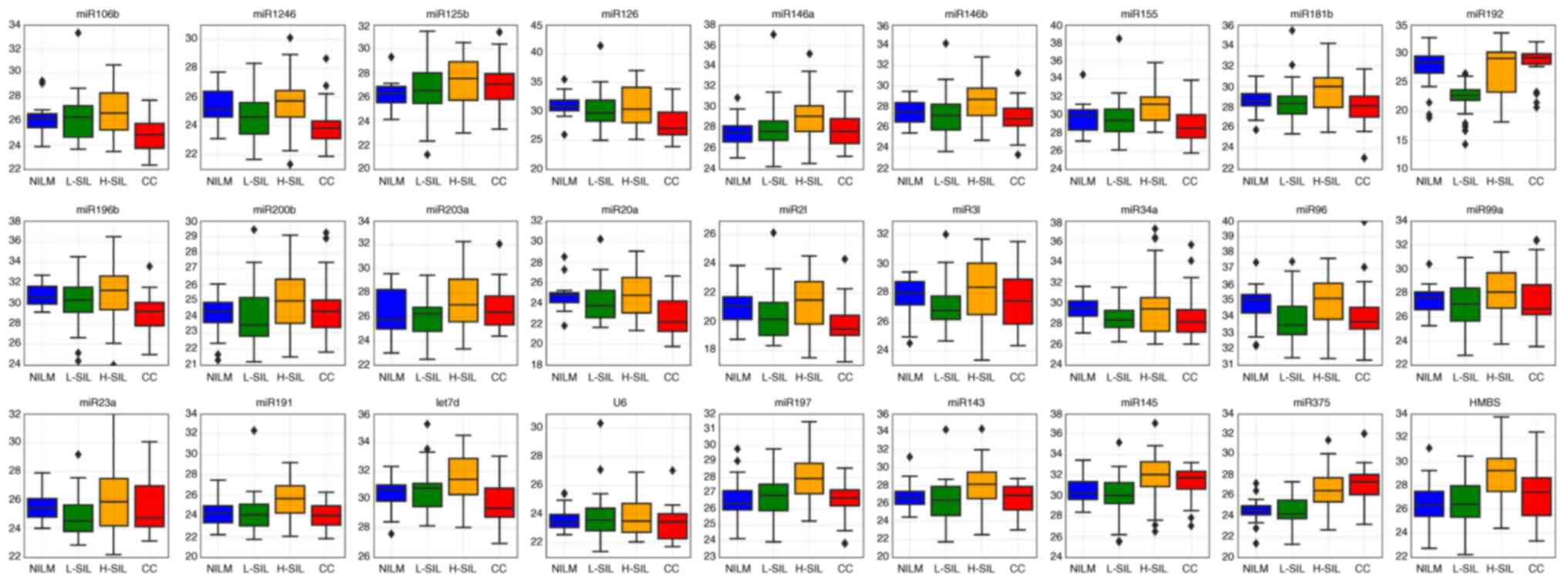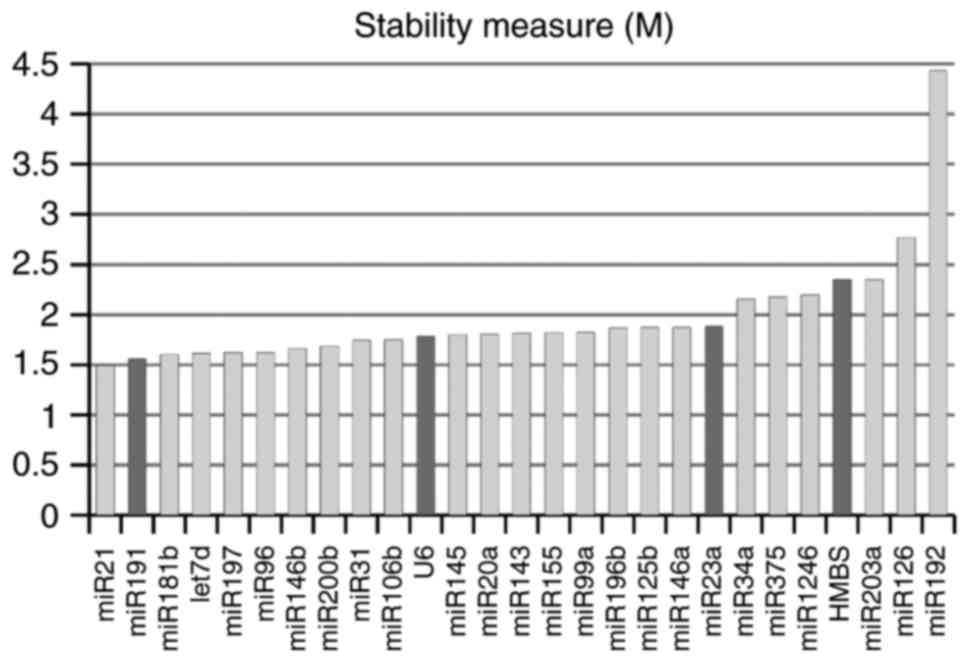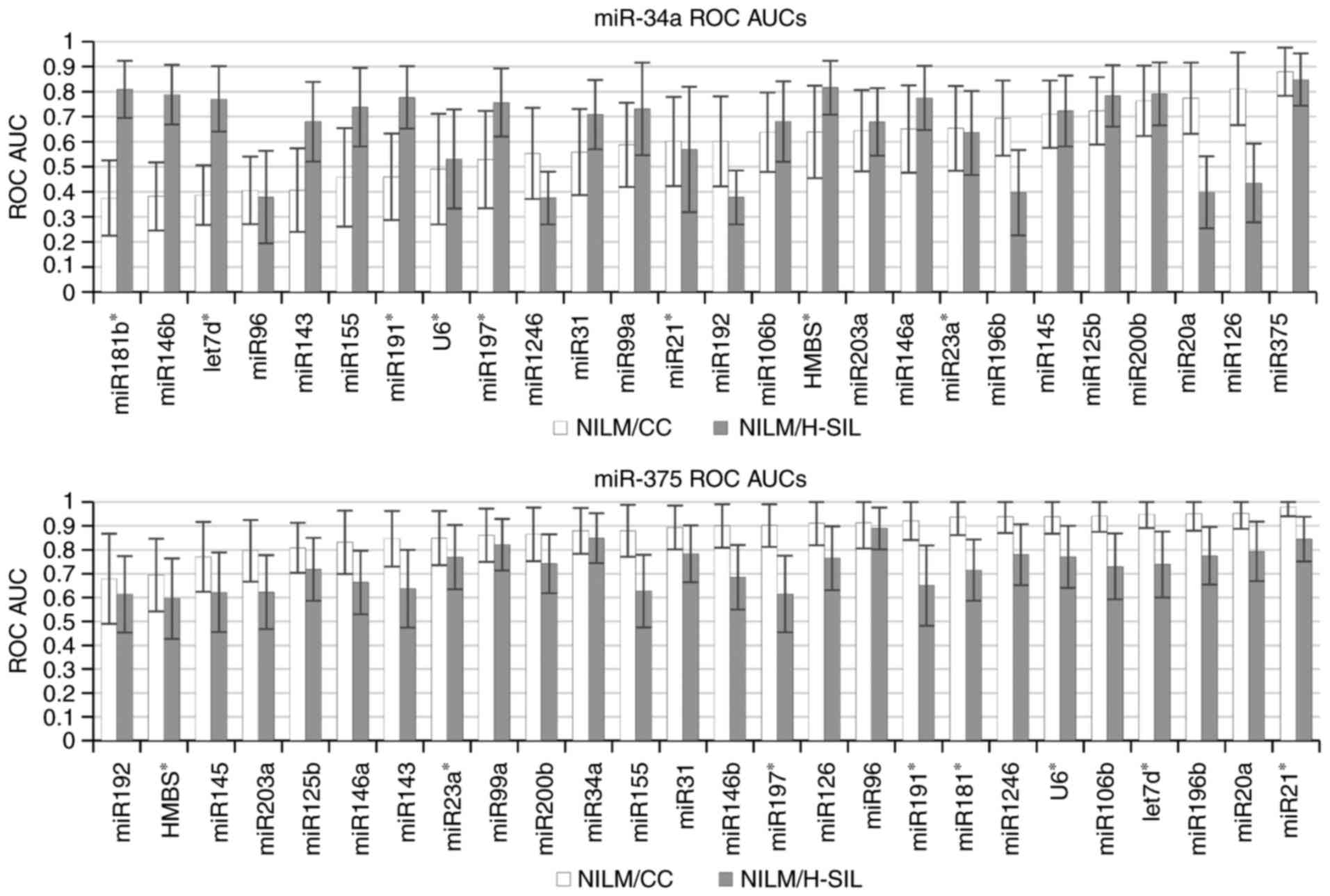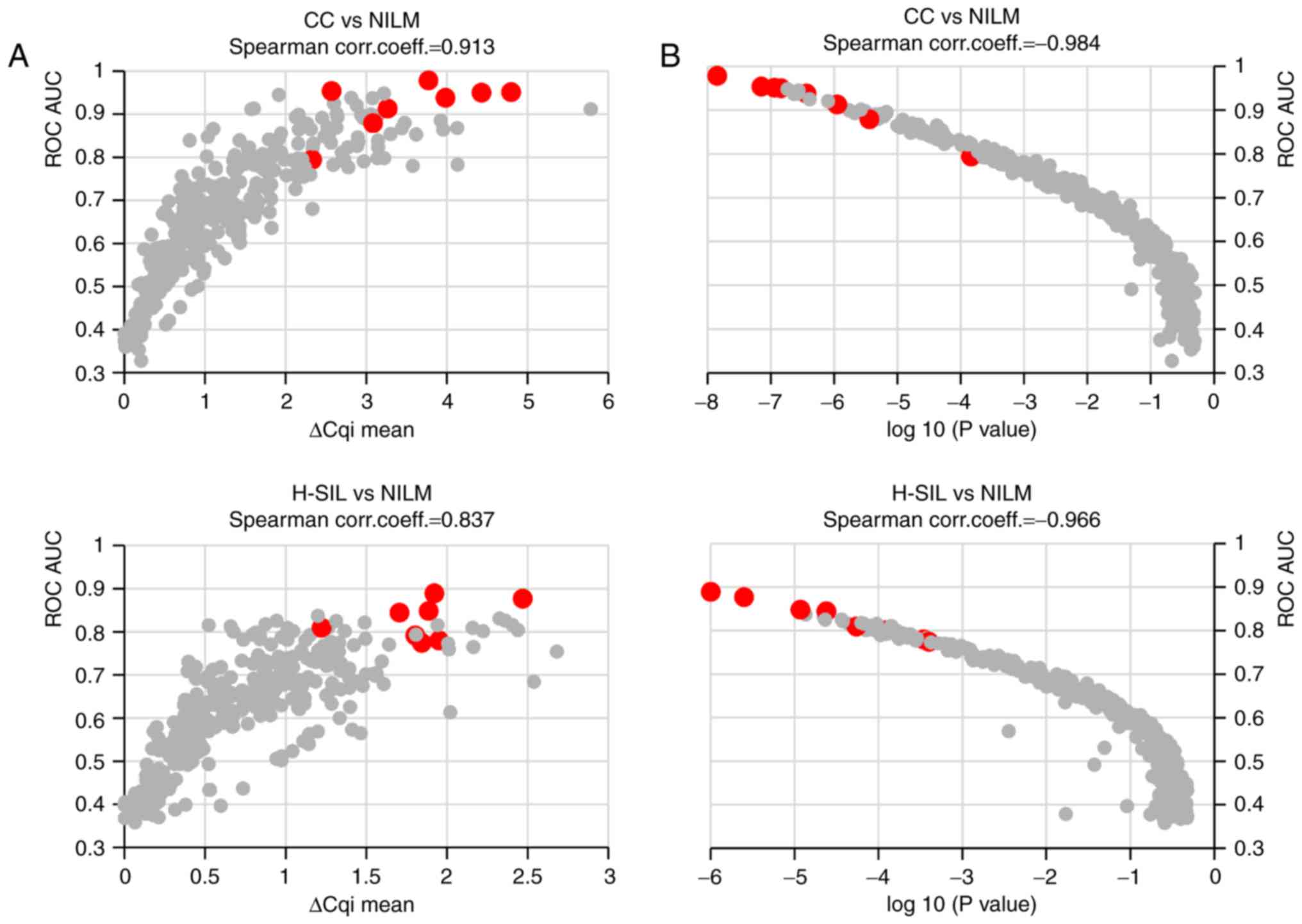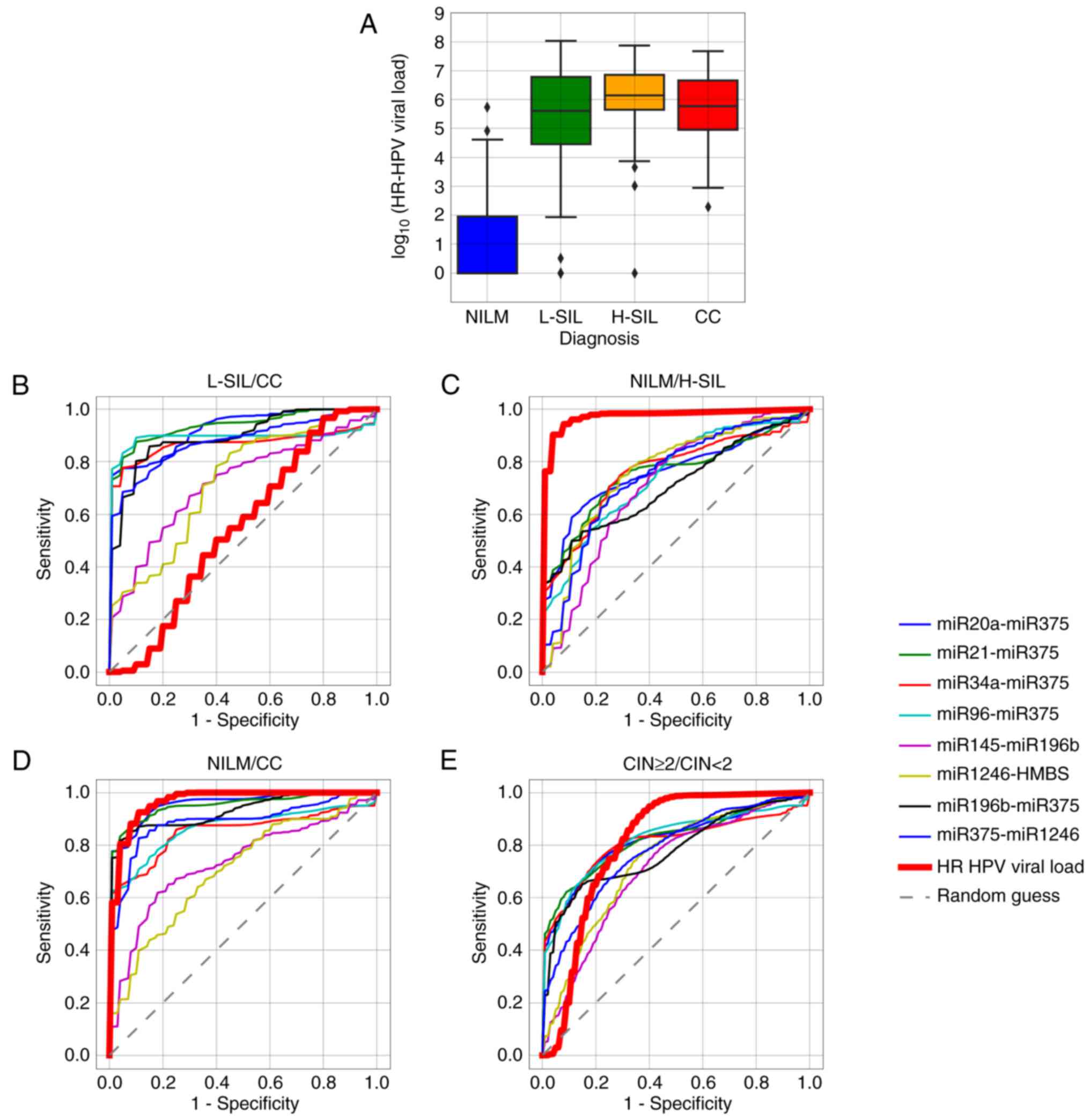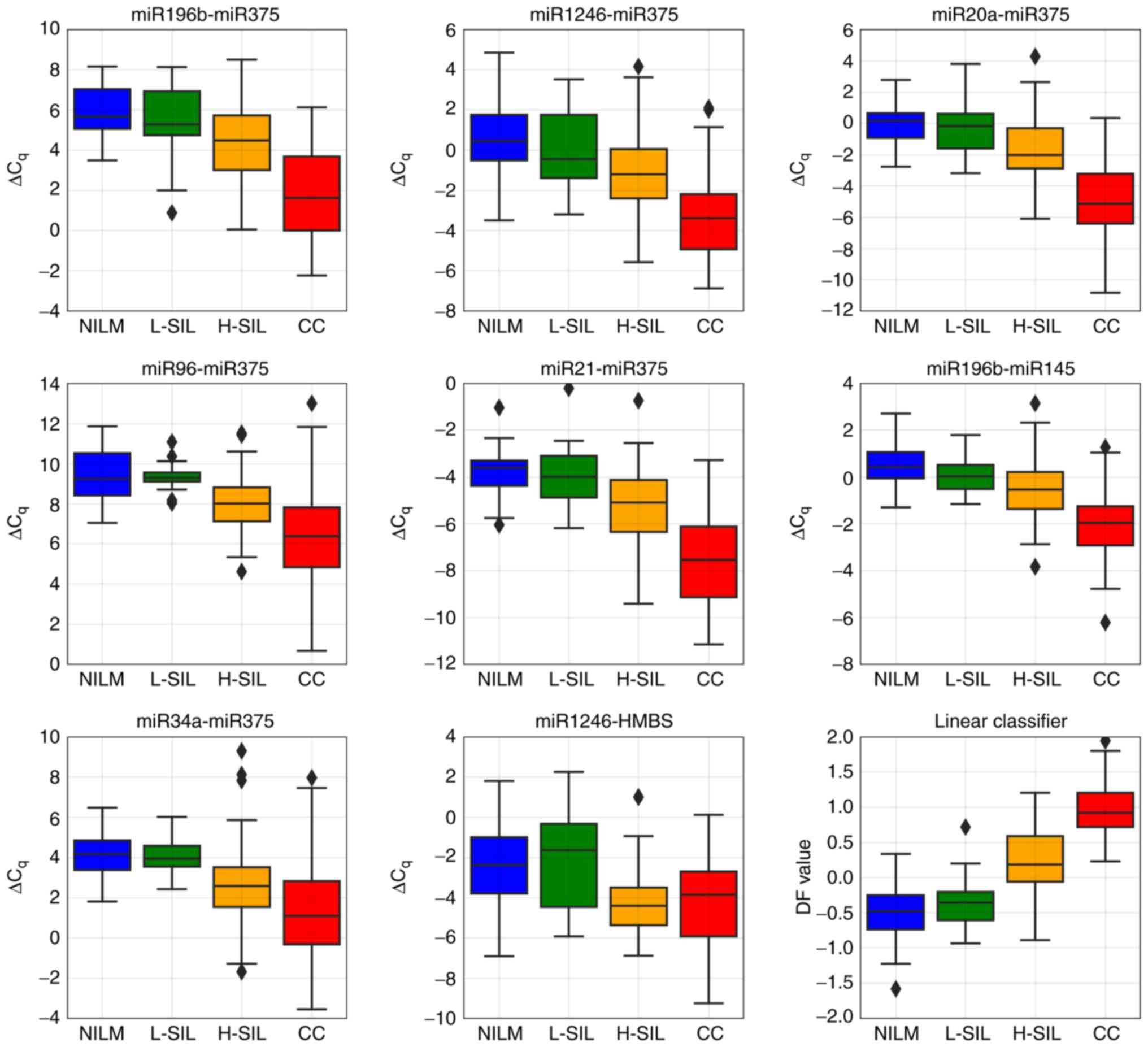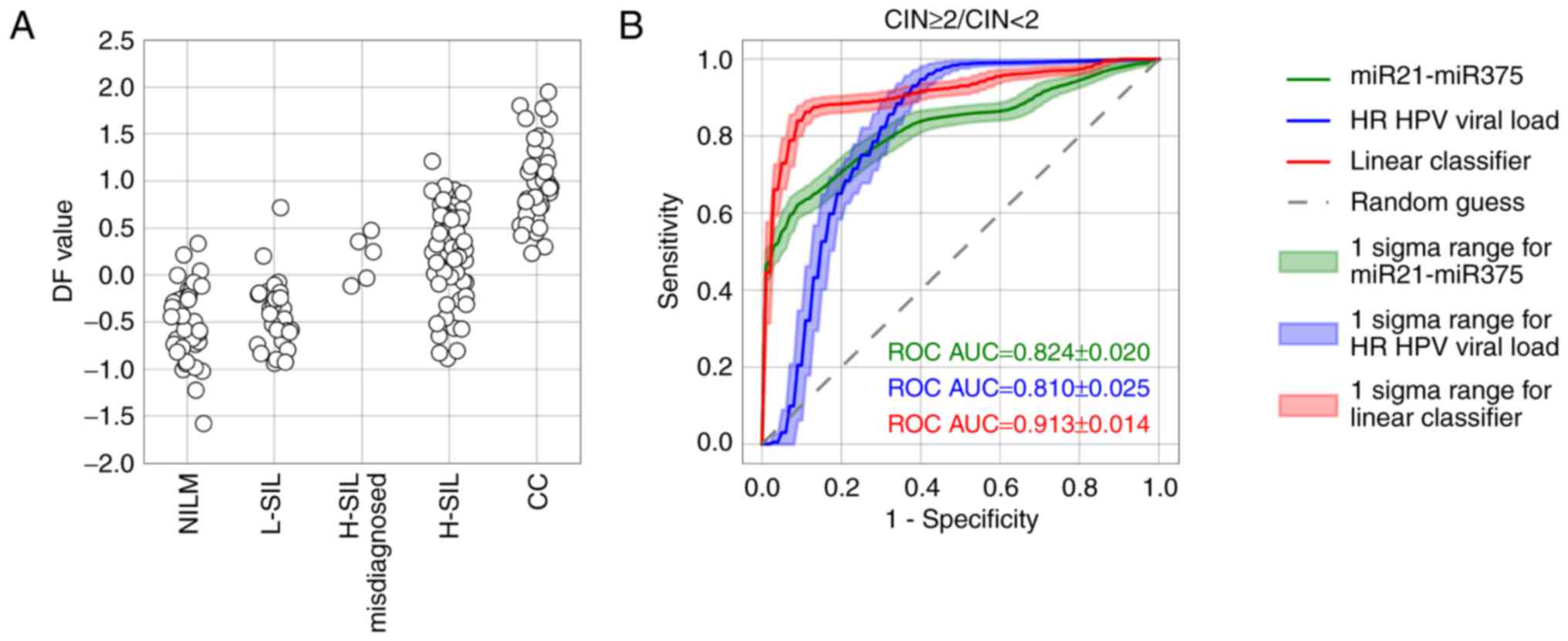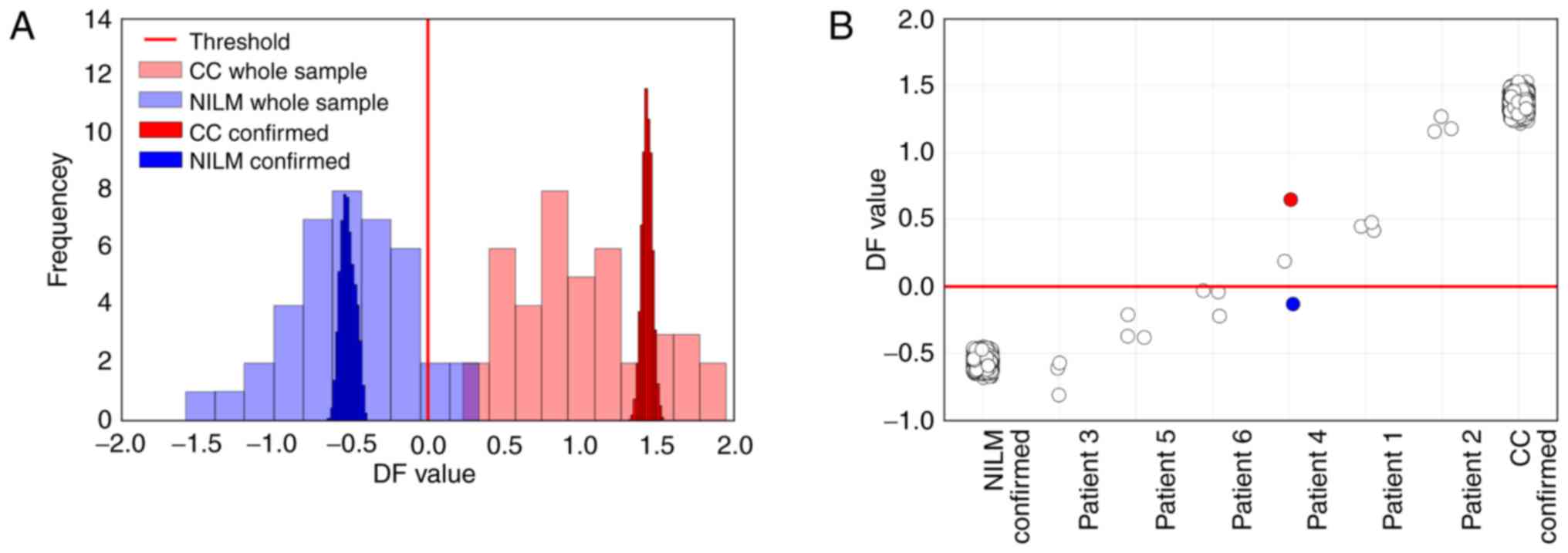Detection of high-grade neoplasia in air-dried cervical PAP smears by a microRNA-based classifier
- Authors:
- Published online on: January 12, 2018 https://doi.org/10.3892/or.2018.6214
- Pages: 1099-1111
-
Copyright: © Ivanov et al. This is an open access article distributed under the terms of Creative Commons Attribution License.
Abstract
Introduction
Cervical cancer (CC) is one of the most common oncological diseases in women worldwide and one of the leading causes of female cancer mortality. One etiological factor for CC is infection with the human papillomavirus of a high carcinogenic risk (hereafter HR-HPV). Epithelial damage tends to progress slowly (10–20 years from contact with HPV to the development of invasive cancer). Therefore, regular cervical screening can allow the detection of most lesions at early stages and drastically reduce the risk of CC. At present, the preferred method for primary cervical screening is cervical cytology, the efficacy of which as a single screening method is limited due to technical constraints, human factors as well as limitations of the pathomorphological classification itself. This results in relatively low and varying sensitivity (50–80% in different clinical settings) and compromised specificity of cervical cytology (1). Another problem is the ambiguity of the prognosis for patients with mild neoplasia (L-SIL) for possible long- and short-term outcomes, from the complete regression to the rapid development of invasive cancer.
The value of cervical screening can be improved by the additional analysis of molecular biomarkers. At present, the only marker widely used in clinical practice is HR-HPV DNA. HPV testing has a higher diagnostic sensitivity than the cytological method for the detection of cervical neoplasia (2,3). Therefore, it is widely used in cervical screening in combination with cytology (4,5) or as a method of primary screening (6,7). However, HR-HPV infection is frequent in women with no signs of cervical neoplasia even at the age of risk (26–30 years and older) (8). In the vast majority of cases, HPV infection is transient and eliminated spontaneously (9). Therefore, despite the high diagnostic sensitivity and negative predictive value (NPV) of HR-HPV testing, its diagnostic specificity and positive predictive value (PPV) in cervical screening are relatively low. High viral load of HPV DNA in older ages is now considered a surrogate marker of the HPV persistence pointing to an increased risk of malignant transformation but the PPV of this indicator is insufficient.
In multiple studies, diagnostic relevance of the wide range of additional molecular biomarkers of dysplastic changes in the cervix has been reported. These include the integrated form of HR-HPV DNA, the amplification of telomerase gene subunits, the levels of various mRNAs and microRNAs, and the aberrant methylation of the promoters of various genes. Moreover, accumulating evidence indicates that some morphologically indistinguishable subgroups of CIN2 and even CIN3 neoplasms have very different long-term chances of malignant transformation. Such subgroups can be discriminated by analyzing the content of molecular markers of genetic and/or epigenetic changes in affected cells [reviewed in ref. (10)].
MicroRNAs play a significant role in the development of all types of cancer including CC. Cervical lesions are always accompanied by an increase or decrease in the levels of various microRNA which are correlated with the severity of the lesion and/or are characteristic of invasive cancer in comparison with preinvasive stages (11–20).
MicroRNAs are markedly stable in clinical material, including cytology specimens. Therefore, they are regarded as perspective clinical biomarkers. Several recent studies have demonstrated the feasibility of using microRNA profiling in cervical samples for diagnostic purposes (18,21,22). At the same time, the inconsistency of accumulated data concerning changes in microRNA levels in the above-mentioned studies impedes the translation of their results into clinical practice. The reported degree and direction of individual microRNA level changes in cervical lesions can vary substantially and be even contradictory in different studies (23–25). This may be due to differences in the techniques used for quantification, the characteristics of the cohorts of enrolled patients, as well as to the different methods of raw data handling. The importance of proper normalization for quantitative estimates of microRNAs is undoubted (26–29). MicroRNAs represent only a small fraction of the total RNA in the cell; moreover, this fraction can vary significantly between different types of specimens. The extraction efficiency of these small molecules can differ significantly from the extraction efficiency of longer RNAs extracted from sample of the same type by the same method. Thus, traditionally used housekeeper mRNAs are not applicable for the normalization of microRNA expression data. At the same time, profiles of microRNA expression are characterized by high tissue and cellular specificity (30), and there are no identified microRNA genes expressed as stably as known protein-coding housekeeping genes. Due to the above difficulties, the normalizers for microRNA quantitation in different tissues and specimen types are often chosen empirically. Depending on the method of reference microRNA selection, different researchers choose different normalizers. The use of geometric mean of the group of normalizers instead of a single reference can reduce the bias introduced by normalization. Such an approach, called GeNorm (31) makes it possible to rank candidate reference genes by their expression stability, based on the calculation of an average pairwise variation between all studied genes, and to determine the optimum set of reference genes required for normalization. However, in the case of microRNA analysis this method either requires all possible normalizers to be analyzed or faces the problem of rational selection of the normalizers. The alternative is utilizing the mean expression value of all expressed microRNAs in a given sample as a normalization factor (27). However, this approach requires a large set of microRNAs to be profiled in a single specimen, which may be unacceptable in clinical practice for both technical and economic reasons.
The aim of the present study was to develop a method for detecting high-grade cervical intraepithelial neoplasia and CC in cytological specimens by PCR-based analysis of a small set of microRNAs.
Materials and methods
Clinical material
The present study was approved by the local Ethics Committee of the Federal Government Budgetary Institution ‘N.N. Petrov Research Institute of Oncology’ as of February 13, 2014 (Internal No. 21). The samples were obtained from patients who underwent examination and treatment at the Oncogynecology Department of the Oncology Research Institute over the period 2010–2016. Cytological examination of cervical smears and histological examination of the surgical material were carried out by specialists at the Cytology Laboratory and Department of Pathomorphology of the Oncology Research Institute, respectively. Cytological specimens were obtained from the archives of the Cytology Laboratory and clinical data were obtained from the database of the Oncology Research Institute. Before the study, the clinical material and information were subjected to anonymization.
The cervical epithelial scrapings were obtained and prepared by routine methods (Papanicolaou staining). The samples were classified according to the Bethesda system (32): normal cytology [negative for intraepithelial lesions or malignancy (NILM)] (n=40, mean age 31), low-grade squamous intraepithelial lesion (L-SIL) (n=34, mean age 36), high-grade squamous intraepithelial lesion (H-SIL) (n=57, mean age 44), invasive cervical cancer (CC) (n=43, mean age 53). All H-SIL and CC diagnoses were histologically verified after subsequent surgical treatment. The coincidence of cytological and histological conclusions was observed in 100% of CC cases. Moderate neoplasia (H-SIL) was confirmed histologically in 88% cases, in the remaining cases (7 of 57, 12%) intra-epithelial cancer (Ca in situ) was revealed. In 5 cases of cytologically diagnosed mild neoplasia (L-SIL), the surgical treatment was prescribed, based on the clinical specifics of the course of the disease. In all these cases, a histological study revealed Ca in situ.
Isolation of total RNA and detection of microRNAs and U6 snRNA by RT-PCR
Isolation of RNA from air-dried cytology preparations was carried out as previously described (33). From the material of cytological preparations, we succeeded in obtaining from 5 to 50 µg of total RNA of satisfactory quality (A 260/280: 1.5–1.8) and in sufficient concentration for quantitative measurements (120–550 ng/µl). The microRNA and U6 snRNA expression were analyzed by stem-loop qPCR as previously described (34). The list of microRNAs was made based on the meta-analysis of related literature data. The following 25 microRNA were selected: hsa-miR-20a-5p (hereinafter referred to as miR-20a), −21-5p, −23a-3p, −31-5p, −34a-5p, −96-5p, −99a-5p, −106b-5p, −125b-5p, −126-3p, −145-5p, −143-3p, −146a-5p, −146b-5p, −155-5p, −181b-5p, −191-5p, −192-5p, −196b-5p, −197-3p, −200b-3p, −203a-3p, −375, −1246, let-7d. For each sample, the content of each marker molecule was measured in single repeat. The results corresponding to Cq >40 were considered negative. Sequences of all oligonucleotides are available upon request.
Identification, genotyping and evaluation of HR-HPV viral DNA load
Identification, genotyping and evaluation of HR-HPV viral DNA load were performed using the ‘RealBest HPV genotype, quantitative’ kit (AO Vector-Best, Russia) according to the manufacturer's instructions. The kit is designed to quantify the viral load of each of 12 HR-HPV genotypes: 16, 18, 31, 33, 35, 39, 45, 51, 52, 56, 58, 59. The viral DNA load, normalized to the number of copies of the human β-actin gene, was calculated independently for each genotype and the total viral DNA load was provided as the sum of loads for different genotypes in the case of multiple infection. In addition, all samples were tested for HPV DNA of genotypes 26, 53, 66, 68, 73 and 82 using the kits ‘RealBest DNA HPV 26/53/66’ and ‘RealBest DNA HPV 68/73/82’ (AO Vector-Best, Russia). In this case, the viral DNA loads were estimated by the ΔΔCq method (35), using the Cq values from amplification of β-actin gene as normalizing factor.
Content of human DNA
In the isolated sample, the number of HMBS gene copies was evaluated using a set of reagents ‘RealBest Sample Validation’ (AO Vector-Best, Russia) in accordance with the manufacturer's instructions.
Statistical analysis
Data analysis was performed using SciPy library (36) of Python programming language. Differences between groups were assessed using the Mann-Whitney U test. The Bonferroni correction was applied to correct for multiple testing. All P-values of <0.05 were considered statistically significant. The receiver operating characteristic (ROC) curve and logistic regression analysis were used to assess the performance of high-grade CIN detection. Classifications were performed using Scikit-learn library (37) of Python programming language. The linear classification algorithm was used. The stability of reference genes was estimated by geNorm algorithm (31).
Results
Raw microRNA Cq values in samples from different lesions
For some microRNAs, the raw Cq values obtained from amplification curves (shown as box-whisker plots in Fig. 1) differed between the different cytological diagnoses. No statistically significant difference was observed for raw Cq values for any microRNA between the L-SIL group and the NILMs and H-SILs (data not shown). However, for some microRNAs, the differences between the groups in pairs NILM/CC, L-SIL/CC and NILM/H-SIL were significant. Thus, the raw Cq values for 6 microRNAs differed significantly for invasive cancers compared to both NILM and H-SIL specimens. For two microRNAs, the significant difference was observed for the NILM group compared to CCs and/or H-SILs (Table I).
Table I.Raw Cq values for several microRNAs that differ between cervical smears from patients with different cytologic diagnoses. |
Estimation of expression stability of selected microRNAs and U6 snRNA
The initial list of suggested normalizers included: miR-191 [according to (26), the expression of this microRNA was the most stable in 13 compared tissues]; miR-23a [as a normalizer suitable for the analysis of cervical samples, according to (38)]; U6 (traditionally used as a stand-alone reference for normalization of microRNA expression data); and HMBS (as a marker reflecting the input number of epitheliocytes). Surprisingly, according to geNorm stability criteria, the most stably expressed was miR-21, which is widely accepted as an oncomiR, including in CC (39–41). In our sample, its level was increased in invasive cancers. At the same time, suggested normalizers U6 and, particularly, miR-23a, demonstrated relatively low stability, which was comparable to the known oncogenic (miR-34, miR-20a) and onco-suppressor (miR-375, miR-143) microRNAs (Fig. 2). All microRNAs as well as U6 snRNA expectedly demonstrated maximum stability in NILM specimens compared to other cytological diagnoses.
Diagnostic utility of paired marker combinations for detection of cervical lesions in cytological preparations
According to the geNorm criterion, the most ‘stably expressed’ among the selected RNAs was not the supposed normalizer but the oncogene. This suggests that the choice of a normalizer based on the evaluation of the expression stability may be an inadequate approach in our case. We evaluated the diagnostic utility of all possible paired combinations of the 27 selected markers (25 microRNAs, U6 snRNA, and HMBS copy number). For each pair of markers A and B, the ΔCqi value (ΔCq = CqA - CqB) was obtained. The number of possible ΔCqi values in our case was 27!/(2!25!) = 351. ΔCqi value is dimensionless, and, on condition of ~100% PCR efficiency, is equal to log2 of the concentration ratio of two marker molecules in the pair. This means that the ΔCqi value does not depend on the amount of input material as each marker in the pair serves as ‘normalizer’ for the other marker.
For each ΔCqi value, 6 different areas under the ROC curves (ROC AUCs) were calculated. This was done to estimate the possibility of each paired marker combination to discriminate the specimens by the cytological diagnosis: NILM/L-SIL, NILM/H-SIL, NILM/CC, L-SIL/H-SIL, L-SIL/CC and H-SIL/CC. To calculate the ROC AUCs, the cross-validation strategy was used. Each time a random subsample including 80% objects of the original sample was generated. The model was trained on this subsample, and the ROC AUC was evaluated based on the remaining 20% objects of the original sample. In this case, the sample was subdivided into the training and test subsamples in such a way that the proportion of specimens with the cytological diagnoses was the same in both. The procedure was repeated 100 times, that is, the ROC AUC for each ΔCqi value was obtained as a result of averaging over 100 calculations. The ROC AUC value >0.8 was considered acceptable for the corresponding paired marker combination to discriminate the samples with different cytology.
The utility of different paired marker combinations for detecting the lesions of different severity varied greatly. However, the same combinations were among the best at separating the ‘neighboring’ classes (NILM from L-SIL, L-SIL from H-SIL, H-SIL from CC). The median and mean ΔCqi values for these combinations increased or decreased stepwise with the severity of the lesion.
For none of the ΔCqi values, ROC AUC exceeded 0.8 at discriminating ‘neighboring’ groups (NILM/L-SIL, L-SIL/H-SIL and H-SIL/CC) (data not shown). At the same time, several paired combinations were characterized by high (>0.8) ROC AUC values at separation of NILMs from H-SILs (n=13), NILMs from CCs (n=61) or NILMs from both H-SILs and CCs (n=11). In Fig. 3 a scatter graph is presented reflecting the ratio between the ROC AUC values for discriminating NILM specimens from CCs (x-axis) and H-SILs (y-axis) for each paired marker combination.
For discriminating specimens with different cytological diagnoses, the highest ROC AUC values were obtained when the levels of two markers in a pair tended to change in the opposite way with the increasing lesion severity. At the same time, combination of the suggested normalizer or the ‘stably expressed’ marker (U6, HMBS, miR-23a, miR-21, miR-191 or miR-181b) with oncogenic or onco-suppressor microRNA (that is, traditional normalization) generally resulted in lower ROC AUC values. This is illustrated in Fig. 4, where ROC AUCs are represented, which are calculated for paired combinations where the first marker in the pair is oncogenic (miR-34a, above) or onco-suppressor microRNA (miR-375, below) and the second marker, serving as ‘normalizer’, is any of the remaining markers from the selected list. This conclusion remains valid also for the use of geometric mean 2, 3 and 4 for the most stably expressed microRNAs (data not shown).
Dependence of ROC AUCs on the number of markers in linear classifiers
The application of the linear classifier method involving a larger number of ΔCqi values resulted in a marked improvement in the quality of classification, compared to the use of the best single ΔCqi values. Up to a certain limit, an increase in the number of ΔCqi values included in the classifier led to an increase in ROC AUC values, after which the inclusion of additional attributes was no longer significant (Fig. 5). As the ΔCqi values included in the classifier changed stepwise with the severity of lesion, the accuracy in detection of the lesion also increased with its severity. As can be seen from Fig. 5, the reliability of H-SIL detection in terms of ROC AUC was lower, compared to CC detection regardless of the number of ΔCqi values included in the classifier.
Selection of the best paired marker combinations for the linear classifier
The results presented in Fig. 5 indicate that the reasonable number of ΔCqi values for inclusion in the final classifier in our case did not exceed 8. Thus, we decided to select 8 ΔCqi values for the construction of the final classifier. The selection was based on the statistical significance of the observed differences at separation of NILM from CC and NILM from H-SIL. The non-parametric Mann-Whitney criterion was used. Taking into account that the statistical criterion was applied twice (for the separation of the classes NILM/CC and NILM/H-SIL), the selected significance level was 0.05/2=0.025. Since we dealt with multiple hypothesis testing (the number of validations in the case of each classification was 351), we applied the Bonferroni correction, which is the most conservative for multiple verification. With this correction, statistically significant differences at a significance level of 0.025 were observed for 53 ΔCqi values at separating NILM from CC and for 14 values at separating NILM from H-SIL (8 ΔCqi values were simultaneously present in these two groups).
We also accepted the required effect size (the difference in the mean ΔCqi values in groups of specimens from different cytology diagnoses) to be ≥1. This was done since in the case when the ΔCqi value did not meet this requirement (effect size <1) it is comparable to the characteristic RT-qPCR bias. In this case, despite the statistical significance of the ΔCqi value, its practical significance was limited by the analytical variation of the method.
In Fig. 6, the correlations between the ROC AUC and the effect size for each ΔCqi value (Fig. 6A) as well as between the ROC AUC and the achieved significance level (ASL) of each ΔCqi value (Fig. 6B) are represented as scatter diagrams.
It can be seen from the figure that the ROC AUC values were correlated to a greater extent with the ASLs than with the effect sizes. The highest ROC AUCs corresponded to ΔCqi values with the lowest ASLs at discriminating the specimens according to their cytological diagnoses. Thus, the ASL value was accepted as the primary criterion for selection of the paired combination. Among the combinations with the lowest ASLs, the combinations with a larger effect size were further selected. In our case, for the top 5 paired combinations with the lowest ASL values (from 1.4x10−8 to 1.8x10−7) at discriminating NILM from CC, the effect size ranged from 2.6 to 4.8. The top 5-paired combinations with the lowest ASLs (from 1.0x10−6 to 2.2x10−5) at discriminating NILM from H-SIL the effect size was smaller (ranged from 1.2 to 2.5) but, nevertheless, exceeded 1, which suggests the feasibility of their use for H-SIL detection by a qPCR-based method.
Thus, we selected 6 paired marker combinations with a high statistical significance. Three of them performed best at discrimination of NILM from CC: miR21-miR375 (AUC=0.978±0.038; P=1.42x10−8), miR145-miR196b (AUC=0.954±0.069; P=7.08x10−8), miR20а-miR375 (AUC=0.951±0.064; P=1.14x10−7). The other three were selected to separate NILM from H-SIL: miR96-miR375 (AUC=0.889±0.088; P=1.00x10−6), miR1246-HMBS DNA (AUC=0.877±0.09; P=2.51x10−6), miR34a-miR375 (AUC=0.848±0.104; P=1.17x10−5). ΔCqi value for each of these combinations differed significantly between the specimens with different diagnoses even with the most conservative Bonferroni correction, and also had satisfactory effect size at discriminating these specimens. Two additional combinations were included in the classifier: miR196b-miR375 and miR375-miR1246. The calculation of these did not require involvement of additional markers but enabled further improvement in the classification quality.
In total, 9 markers were selected for the classifier: 8 microRNAs (miR-20а, miR-21, miR-34a, miR-96, miR-145, miR-196b, miR-375 and miR-1246) and cellular DNA content. The difference between invasive cancers and NILMs was statistically significant even for the raw Cq values for most of these microRNAs (except for miR-34a, see Table I).
Absence of correlation between the microRNA level changes and HR-HPV viral load in cytological specimens
The proportion of HR-HPV-positive samples with different cytological diagnoses, as well as the median and mean viral DNA loads, are provided in Table II. In all invasive cancers, except three, HPV16 and/or HPV18 DNA was detected. In one of these, only HPV73 DNA was found, in another - only HPV45, in the third - HPV73 and HPV45 simultaneously. Viral DNA loads in all these cases exceeded 107/108 copies of epithelial cell DNA. It should be noted that in our sample there were no NILM specimens with high HR-HPV DNA viral loads, although this is a fairly common situation even in the risk age group.
For none of the microRNAs, regardless of the normalization method, statistically significant correlation with the HR-HPV DNA load, genotype, or the number of genotypes in case of multiple infections was observed. The levels of several microRNAs notably differed between the HR-HPV-positive L-SILs and invasive cancers, while the viral loads did not differ significantly between these groups of specimens (Fig. 7A and B). Important to note, in our sample the viral load differed significantly in H-SILs and CCs compared to HR-HPV-positive NILMs (Fig. 7C and D). This may be partly due to the above-mentioned absence of NILMs with high HR-HPV viral loads. Nevertheless, for discrimination between subsamples of the CIN ≥2 specimens from the rest of the sample (CIN <2) some single ΔCqi values performed as well as the viral DNA load or even surpassed it (Fig. 7E).
Training of the linear classifier
Training of the linear classifier based on 8 ΔCqi values was performed with a sample of 171 specimens. Three CC samples with a highly degraded biomaterial (Cq values for HMBS and most marker microRNAs close to 40) were excluded from analysis. The decision function value (hereafter referred to as DF value) calculated by the classifier is dimensionless. In Fig. 8, the diagnostic characteristics of the trained classifier for discrimination between different groups of cervical specimens depending on the selected cut-offs are presented.
Fig. 9 presents box-whisker plots for 8 ΔCqi values included in the classifier and a box-whisker plot for DF values obtained for discriminating high-grade lesions (CIN ≥2) from the rest of the sample.
As the marker of high-grade lesions (CIN ≥2), the DF value performed better than the viral load or any ΔCqi value (ROC AUC=0.913, diagnostic sensitivity=83.4%, diagnostic specificity=81.2% at maximum Youden index) (Fig. 10B). Nevertheless, the DF value ranges sufficiently overlapped between groups of samples with different pathomorphological diagnoses (Fig. 10A). This overlap may result from the combined effect of the analytical biases, biological variation in the marker RNA levels, the cellular heterogeneity of cervical specimens, and the cytology misclassification.
Estimation of method reproducibility
The accuracy of DF value measuring results obviously depends on the analytical variation of RT-PCR. To evaluate the possible contribution of RT-PCR bias, we re-analyzed extracted nucleic acid preparations from two cytological specimens (from NILM and CC patients), in which each marker was analyzed 4-fold and each Cq value obtained for each marker in the sample was used in repeated calculations of DF value for this sample. In Fig. 11A, the histograms of DF values for each specimen (calculated for 10,000 randomly selected combinations of the obtained Cq values from the possible 4.3x109 combinations) and the histograms of DF values for the NILMs and CCs are presented. The histograms of DF values for specimens are several times narrower than the histograms of DF values for the NILM and CC classes, which means that the contribution of RT-PCR bias into the accuracy of the DF value calculation was not high.
For 6 patients with different cytological diagnoses, 3 PAP slides prepared from a single smear were tested. In Fig. 11B, the DF values calculated for the nucleic acid preparations extracted from each slide are provided compared to 10,000 DF values for NILM and CC samples calculated as described above. For 5 out of 6 patients, the variation between the slides was comparable to the RT-PCR bias. Nevertheless, for patient no. 4, different classification results for the different slides were obtained. We suggest that the observed variation was determined to a greater extent by the procedure of preparing the slide (which affects the amount and integrity of the material analyzed) than by the nucleic acid extraction procedure. Thus, in the case of patient no. 4, the maximum DF value (marked red in Fig. 11B) corresponded to the slide for which the HMBS DNA Cq value was ~39 and most Cq values for microRNA markers were beyond the linear range of qPCR. The minimum DF value (marked blue) corresponded to the slide from the same patient, where HMBS DNA Cq was ~33 (~100-fold greater concentration of input cellular DNA) and Cq values for microRNA markers were within the qPCR linear range, which suggest that the classification results for this slide were more reliable.
When comparing the ROC AUCs for DF values calculated for subsamples of specimens with very different nucleic acid concentrations (the difference between the max and min Cq values for HMBS=11.5, the difference between the max and min Cq values for the most stably expressed miR-21=9.5), we observed no difference. In addition, we re-classified 3 samples after the 4-fold dilution of nucleic acid preparation. The differences in the obtained DF values were within the limits of the variation evaluated in the previous experiment and in no case led to reclassification of the sample compared to non-diluted preparation (data not shown). Taken together, these facts support the lack of a significant contribution made by PCR efficiency to the classification reliability.
Discussion
Recent research demonstrates the feasibility of using microRNAs as biomarkers in cervical cancer (CC) screening and follow-up. However, the reliable detection of biologically relevant changes in microRNA levels may be compromised by the variability introduced by the methodology of analysis and the cellular heterogeneity of clinical specimens. It is this problem that may account for the fact that none of the numerous but diverse design and methodology methods has achieved acceptable diagnostic characteristics when using microRNA profiling for the diagnosis of cervical neoplasia.
As mentioned above, the lists of the microRNA markers, deregulation of which accompanies cervical lesions of different degrees, as well as the direction of their concentration changes, often differ between different studies. This can certainly be attributed to the peculiarities of the microRNA isolation and quantitation techniques used. Each technology of microRNA profiling (microarrays, NanoString counting, RNA-seq, TaqMan low density array) has its own sources of bias. Even the widely used techniques for microRNA analysis (Exiqon and TaqMan), based on similar RT-qPCR techniques, demonstrate serious discrepancies in the efficiency of detecting various microRNAs (42–46). To search for the most suitable markers for the further design of microRNA diagnostic tools, researchers typically analyze a limited sample of patients by microarrays or RNAseq, which allows one to choose from the great number of microRNAs; then candidate microRNAs are validated by real-time PCR. This approach may result in neglecting some relevant microRNAs due to lower efficiency of their detection by chip-based methods or RNA-seq biases.
The normalization method is another apparent factor affecting the reliability of microRNA quantification. In cases where the disease-associated microRNA level changes are relatively small (as in high-grade CINs), the choice of the normalization strategy is particularly important, since in such cases the biologically relevant microRNA expression changes may be comparable to the biases introduced by the method. Some authors have proposed individual normalizers for microRNA level measurements in cervical epithelium by real-time qPCR, e.g., U6 snRNA (18,21,23,47), miR-23 (22,38) and miR-92a (48). The use of such normalizers by our research group did not lead to favorable results for the classification of cervical lesions in cytological preparations. Moreover, classification results were strongly normalizer-dependent. With some normalizers, ‘wave-like’ changes in the content of particular microRNAs with the increase in lesion severity from NILM to CC were observed (data not shown). Such changes were not consistent with the known biological functions of these microRNAs and can be considered artifacts of the analysis. On the contrary, the use of the classifier based on paired microRNA combinations selected as described above led to better classification results than any single normalizer or geometrical mean of the 3–5 most ‘stably expressed’ microRNAs. This can be attributed to the following. i) The amplitudes of disease-related microRNA level changes may be comparable to the analytical variation of the method used, which hinders the reliable registration of such changes. The paired marker approach (where the concentrations of two markers in the pair, the levels of which change in opposite directions at neoplastic transformation, are reciprocally normalized) helps to better distinguish biologically relevant change in microRNA profile from the ‘noise’ (the fluctuation of measurement results due to analytical variation). This approach, compared to traditional normalization, better compensates for the biases caused by the analytical variation of the method and/or the cellular heterogeneity of the specimen. The lower the level of physiological changes in the content of the marker is, the greater the contribution of this compensation. Similarly to the traditional normalization, this approach also compensates for the variation associated with the amount and degradation level of input biomaterial. ii) The use of normalizers selected by formal criteria can generate a system error. Thus, in the present study, the most ‘stably expressed’ microRNA was miR-21. For this microRNA, known as oncogenic in multiple cancers including CC, one could expect the increase in concentration accompanying cervical neoplastic transformation. In our case, this was most likely, as even without any normalization the decline in raw miR-21 Cq values in H-SIL and CC compared to NILM was statistically significant (Table I). The use of a normalizer whose concentration itself de facto increases with the severity of the lesion, will inevitably lower or even mask the statistically significant concentration changes of the relevant microRNAs, the levels of which also tend to decline in precancerous lesions and cancer. iii) The cell heterogeneity of the analyzed preparation may result in ‘watering down’ the observed microRNA level changes. The specimen may contain cells corresponding to the different degree of neoplasia in different proportions. In addition, the cytological preparation may contain an admixture of cells not related to the lesion. Thus, the resulting microRNA profile may appear ‘intermediate’, which will complicate the classification. In the analysis of cytological specimens, it is particularly difficult to take into account and compensate for this source of biases. In addition, it cannot be ruled out that neoplasms considered as belonging to a single class based on pathomorphological classification can in fact represent different subclasses for which microRNA expression profiles differ.
In the present study, the best individual microRNA marker of cervical neoplasia was miR-375, which was present in 6 of 8-paired combinations included into the classifier. This was the only microRNA, for which the median ΔCqi values changed monotonically in the range NILM/L-SIL/H-SIL/CC regardless of the second marker (‘normalizer’) in the paired combination. The mean ΔCqi values calculated for the combinations including this microRNA also demonstrated the greatest difference between the lesions of different severity. miR-375 is a known tumor suppressor involved in the development of CC (21,49). The other microRNAs included in the classifier displayed a tendency for increase or decrease with the degree of lesion, which, however, was significantly dependent on the choice of the normalizer.
Thus, we developed a technique for detecting cervical precancerous lesions and cancer in cytological specimens using a microRNA-based classifier. The method demonstrated acceptable diagnostic characteristics and analytical reproducibility. The analysis can be performed with the same nucleic acid preparation as used for HPV testing, genotyping, and the measurement of the HR-HPV viral DNA load. It is now generally accepted that the detection of HR-HPV DNA has a high NPV for precancerous cervical lesions while its PPV is low due to the high frequency of transient HPV carriage without cellular transformation. The differences in microRNA expression more likely reflect cellular events related to transformation and, therefore, may provide a higher PPV if used as a diagnostic marker. Nevertheless, the NPV of such an analysis can also remain significant. In our case, in sample no. 129 with a cytological diagnosis of H-SIL and a histologically confirmed CIN3, in which HPV DNA was not detected, the DF value corresponded to high-grade CIN. Our results support the feasibility of using small-scale microRNA profiling for detection of high-grade cervical intraepithelial neoplasia. Taking into account the very high NPV of HPV-testing in cervical screening, the microRNA profiling and the HR-HPV DNA testing may serve as complementary tools in the molecular testing for cervical lesions.
Some limitations of our research should be emphasized. First, the choice of microRNA markers was made from a limited set, which in itself could fail to be optimal. Secondly, the sample was relatively small and enriched with invasive cancers, which could have led to overestimating the diagnostic characteristics of the classifier. Thirdly, the study was a single-setting. A separate issue in our case is the interpretation of the results of the analysis of samples cytologically characterized as NILM. Since in our case this diagnosis was not verified, we cannot exclude misclassification of some preparations from this group. Further clinical validation of the developed microRNA-based classifier and its use in multicenter and follow-up studies will additionally substantiate the conclusion concerning the prospects of its clinical use.
Glossary
Abbreviations
Abbreviations:
|
CIN |
cervical intraepithelial neoplasia |
|
HR-HPV |
high-risk human papillomavirus |
|
DF value |
decision funtion value |
|
NILM |
negative for intraepithelial lesion or malignancy |
|
L-SIL |
low-grade squamous intraepithelial lesion |
|
H-SIL |
high-grade squamous intraepithelial lesion |
|
CC |
cervical cancer |
|
PPV |
positive predictive value |
|
RT-qPCR |
quantitative reverse-transcription real-time PCR |
|
Cq |
quantification cycle |
References
|
Kitchener HC, Almonte M, Thomson C, Wheeler P, Sargent A, Stoykova B, Gilham C, Baysson H, Roberts C, Dowie R, et al: HPV testing in combination with liquid-based cytology in primary cervical screening (ARTISTIC): A randomised controlled trial. Lancet Oncol. 10:672–682. 2009. View Article : Google Scholar : PubMed/NCBI | |
|
Naucler P, Ryd W, Törnberg S, Strand A, Wadell G, Elfgren K, Rådberg T, Strander B, Johansson B, Forslund O, et al: Human papillomavirus and papanicolaou tests to screen for cervical cancer. N Engl J Med. 357:1589–1597. 2007. View Article : Google Scholar : PubMed/NCBI | |
|
Whitlock EP, Vesco KK, Eder M, Lin JS, Senger CA and Burda BU: Liquid-based cytology and human papillomavirus testing to screen for cervical cancer: A systematic review for the U.S. preventive services task force. Ann Intern Med. 155:687–697, W214-W215. 2011. View Article : Google Scholar : PubMed/NCBI | |
|
Naucler P, Ryd W, Törnberg S, Strand A, Wadell G, Elfgren K, Rådberg T, Strander B, Forslund O, Hansson BG, et al: Efficacy of HPV DNA testing with cytology triage and/or repeat HPV DNA testing in primary cervical cancer screening. Natl Cancer Inst. 101:88–99. 2009. View Article : Google Scholar | |
|
Benoy IH, Vanden Broeck D, Ruymbeke MJ, Sahebali S, Arbyn M, Bogers JJ, Temmerman M and Depuydt CE: Prior knowledge of HPV status improves detection of CIN2+ by cytology screening. Am J Obstet Gynecol. 205:569, e1–e7. 2011. View Article : Google Scholar | |
|
Faridi R, Zahra A, Khan K and Idrees M: Oncogenic potential of human papillomavirus (HPV) and its relation with cervical cancer. Virol J. 8:2692011. View Article : Google Scholar : PubMed/NCBI | |
|
Franceschi S, Denny L, Irwin KL, Jeronimo J, Lopalco PL, Monsonego J, Peto J, Ronco G, Sasieni P and Wheeler CM: EUROGIN 2010 roadmap on cervical cancer prevention. Int J Cancer. 128:2765–2774. 2011. View Article : Google Scholar : PubMed/NCBI | |
|
Arbyn M, Sasieni P, Meijer CJ, Clavel C, Koliopoulos G and Dillner J: Chapter 9: Clinical applications of HPV testing: A summary of meta-analyses. Vaccine. 24 Suppl 3:S3/78–89. 2006. View Article : Google Scholar | |
|
de Sanjosé S, Diaz M, Castellsagué X, Clifford G, Bruni L, Muñoz N and Bosch FX: Worldwide prevalence and genotype distribution of cervical human papillomavirus DNA in women with normal cytology: A meta-analysis. Lancet Infect Dis. 7:453–459. 2007. View Article : Google Scholar : PubMed/NCBI | |
|
Steenbergen RD, Snijders PJ, Heideman DA and Meijer CJ: Clinical implications of (epi)genetic changes in HPV-induced cervical precancerous lesions. Nat Rev Cancer. 14:395–405. 2014. View Article : Google Scholar : PubMed/NCBI | |
|
Martinez I, Gardiner AS, Board KF, Monzon FA, Edwards RP and Khan SA: Human papillomavirus type 16 reduces the expression of microRNA-218 in cervical carcinoma cells. Oncogene. 27:2575–2582. 2008. View Article : Google Scholar : PubMed/NCBI | |
|
Melar-New M and Laimins LA: Human papillomaviruses modulate expression of microRNA 203 upon epithelial differentiation to control levels of p63 proteins. J Virol. 84:5212–5221. 2010. View Article : Google Scholar : PubMed/NCBI | |
|
Greco D, Kivi N, Qian K, Leivonen SK, Auvinen P and Auvinen E: Human papillomavirus 16 E5 modulates the expression of host microRNAs. PLoS One. 6:e216462011. View Article : Google Scholar : PubMed/NCBI | |
|
Zheng ZM and Wang X: Regulation of cellular miRNA expression by human papillomaviruses. Biochim Biophys Acta. 1809:668–677. 2011. View Article : Google Scholar : PubMed/NCBI | |
|
Lajer CB, Garnæs E, Friis-Hansen L, Norrild B, Therkildsen MH, Glud M, Rossing M, Lajer H, Svane D, Skotte L, et al: The role of miRNAs in human papilloma virus (HPV)-associated cancers: Bridging between HPV-related head and neck cancer and cervical cancer. Br J Cancer. 117:e22017. View Article : Google Scholar : PubMed/NCBI | |
|
Gómez-Gómez Y, Organista-Nava J and Gariglio P: Deregulation of the miRNAs expression in cervical cancer: Human papillomavirus implications. Biomed Res Int. 2013:4070522013. View Article : Google Scholar : PubMed/NCBI | |
|
Pedroza-Torres A, López-Urrutia E, Garcia-Castillo V, Jacobo-Herrera N, Herrera LA, Peralta-Zaragoza O, López-Camarillo C, De Leon DC, Fernández-Retana J, Cerna-Cortés JF, et al: MicroRNAs in cervical cancer: Evidences for a miRNA profile deregulated by HPV and its impact on radio-resistance. Molecules. 19:6263–6281. 2014. View Article : Google Scholar : PubMed/NCBI | |
|
Wang X, Wang HK, Li Y, Hafner M, Banerjee NS, Tang S, Briskin D, Meyers C, Chow LT, Xie X, et al: microRNAs are biomarkers of oncogenic human papillomavirus infections. Proc Natl Acad Sci USA. 111:pp. 4262–4267. 2014; View Article : Google Scholar : PubMed/NCBI | |
|
Gocze K, Gombos K, Kovacs K, Juhasz K, Gocze P and Kiss I: MicroRNA expressions in HPV-induced cervical dysplasia and cancer. Anticancer Res. 35:523–530. 2015.PubMed/NCBI | |
|
He Y, Lin J, Ding Y, Liu G, Luo Y, Huang M, Xu C, Kim TK, Etheridge A, Lin M, et al: A systematic study on dysregulated microRNAs in cervical cancer development. Int J Cancer. 138:1312–1327. 2016. View Article : Google Scholar : PubMed/NCBI | |
|
Tian Q, Li Y, Wang F, Li Y, Xu J, Shen Y, Ye F, Wang X, Cheng X, Chen Y, et al: MicroRNA detection in cervical exfoliated cells as a triage for human papillomavirus-positive women. J Natl Cancer Inst. 106:pii:dju2412014. View Article : Google Scholar | |
|
Ribeiro J, Marinho-Dias J, Monteiro P, Loureiro J, Baldaque I, Medeiros R and Sousa H: miR-34a and miR-125b expression in HPV infection and cervical cancer development. Biomed Res Int. 2015:3045842015. View Article : Google Scholar : PubMed/NCBI | |
|
Pereira PM, Marques JP, Soares AR, Carreto L and Santos MA: MicroRNA expression variability in human cervical tissues. PLoS One. 5:e117802010. View Article : Google Scholar : PubMed/NCBI | |
|
Galamb Á, Benczik M, Zinner B, Vígh E, Baghy K, Jeney C, Kiss A, Lendvai G and Sobel G: Dysregulation of microRNA expression in human cervical preneoplastic and neoplastic lesions. Pathol Oncol Res. 21:503–508. 2015. View Article : Google Scholar : PubMed/NCBI | |
|
Ogechukwu OJ: Discordant reports of miRNA expression in cervical cancer: An upshot of overlapping factors. Res Cancer Tumor. 4:15–23. 2015. | |
|
Peltier HJ and Latham GJ: Normalization of microRNA expression levels in quantitative RT-PCR assays: Identification of suitable reference RNA targets in normal and cancerous human solid tissues. RNA. 14:844–852. 2008. View Article : Google Scholar : PubMed/NCBI | |
|
Mestdagh P, Van Vlierberghe P, De Weer A, Muth D, Westermann F, Speleman F and Vandesompele J: A novel and universal method for microRNA RT-qPCR data normalization. Genome Biology. 10:R642009. View Article : Google Scholar : PubMed/NCBI | |
|
Pradervand S, Weber J, Thomas J, Bueno M, Wirapati P, Lefort K, Dotto GP and Harshman K: Impact of normalization on miRNA microarray expression profiling. RNA. 15:493–501. 2009. View Article : Google Scholar : PubMed/NCBI | |
|
Kirschner MB, van Zandwijk N and Reid G: Cell-free microRNAs: Potential biomarkers in need of standardized reporting. Front Genet. 4:562013. View Article : Google Scholar : PubMed/NCBI | |
|
Ludwig N, Leidinger P, Becker K, Backes C, Fehlmann T, Pallasch C, Rheinheimer S, Meder B, Stähler C, Meese E and Keller A: Distribution of miRNA expression across human tissues. Nucleic Acids Res. 44:3865–3877. 2016. View Article : Google Scholar : PubMed/NCBI | |
|
Vandesompele J, De Preter K, Pattyn F, Poppe B, Van Roy N, De Paepe A and Speleman F: Accurate normalization of real-time quantitative RT-PCR data by geometric averaging of multiple internal control genes. Genome Biol. 3:RESEARCH00342002. View Article : Google Scholar : PubMed/NCBI | |
|
Solomon D, Davey D, Kurman R, Moriarty A, O'Connor D, Prey M, Raab S, Sherman M, Wilbur D, Wright T Jr, et al: The 2001 Bethesda System: Terminology for reporting results of cervical cytology. JAMA. 287:2114–2119. 2002. View Article : Google Scholar : PubMed/NCBI | |
|
Kolesnikov NN, Titov SE, Veryaskina YA, Vladimirova AV, Samsonov RB, Artem'eva AS, Novik VI, Bershteyn LM, Zhimulev IF, Malek AV, et al: Improvement of accuracy and diagnostic significance of breast tumor fine-needle aspiration biopsy by miRNA analysis of material isolated from cytological smears. Uspehi Molekulârnoj Onkologii. 3:44–52. 2016. View Article : Google Scholar | |
|
Titov SE, Demenkov PS, Ivanov MK, Malakhina ES, Poloz TL, Tsivlikova EV, Ganzha MS, Shevchenko SP, Gulyaeva LF and Kolesnikov NN: Selection and validation of miRNAs as normalizers for profiling expression of microRNAs isolated from thyroid fine needle aspiration smears. Oncology Rep. 36:2501–2510. 2016. View Article : Google Scholar | |
|
Livak KJ and Schmittgen TD: Analysis of relative gene expression data using real-time quantitative PCR and the 2ΔΔCT method. Methods. 25:402–408. 2001. View Article : Google Scholar : PubMed/NCBI | |
|
Jones E, Oliphant E and Peterson P: SciPy: Open source scientific tools for python. 2001, http://www.scipy.org/July 24–2017 View Article : Google Scholar | |
|
Pedregosa F, Varoquaux G, Gramfort A, Michel V, Thirion B, Grisel O, Blondel M, Prettenhofer P, Weiss R, Dubourg V, et al: Scikit-learn: Machine learning in python. J Mach Learn Res. 12:2825–2830. 2011. | |
|
Shen Y, Li Y, Ye F, Wang F, Wan X, Lu W and Xie X: Identification of miR-23a as a novel microRNA normalizer for relative quantification in human uterine cervical tissues. Exp Mol Med. 43:358–366. 2011. View Article : Google Scholar : PubMed/NCBI | |
|
Deftereos G, Corrie SR, Feng Q, Morihara J, Stern J, Hawes SE and Kiviat NB: Expression of mir-21 and mir-143 in cervical specimens ranging from histologically normal through to invasive cervical cancer. PLoS One. 6:e284232011. View Article : Google Scholar : PubMed/NCBI | |
|
Bumrungthai S, Ekalaksananan T, Evans MF, Chopjitt P, Tangsiriwatthana T, Patarapadungkit N, Kleebkaow P, Luanratanakorn S, Kongyingyoes B, Worawichawong S and Pientong C: Up-regulation of miR-21 is associated with cervicitis and human papillomavirus infection in cervical tissues. PLoS One. 10:e01271092015. View Article : Google Scholar : PubMed/NCBI | |
|
Han Y, Xu GX, Lu H, Yu DH, Ren Y, Wang L, Huang XH, Hou WJ, Wei ZH, Chen YP, et al: Dysregulation of miRNA-21 and their potential as biomarkers for the diagnosis of cervical cancer. Int J Clin Exp Pathol. 8:7131–7139. 2015.PubMed/NCBI | |
|
Git A, Dvinge H, Salmon-Divon M, Osborne M, Kutter C, Hadfield J, Bertone P and Caldas C: Systematic comparison of microarray profiling, real-time PCR, and next-generation sequencing technologies for measuring differential microRNA expression. RNA. 16:991–1006. 2010. View Article : Google Scholar : PubMed/NCBI | |
|
Jensen SG, Lamy P, Rasmussen MH, Ostenfeld MS, Dyrskjøt L, Orntoft TF and Andersen CL: Evaluation of two commercial global miRNA expression profiling platforms for detection of less abundant miRNAs. BMC Genomics. 12:4352011. View Article : Google Scholar : PubMed/NCBI | |
|
Kolbert CP, Feddersen RM, Rakhshan F, Grill DE, Simon G, Middha S, Jang JS, Simon V, Schultz DA, Zschunke M, et al: Multi-platform analysis of microRNA expression measurements in RNA from fresh frozen and FFPE tissues. PLoS One. 8:e525172013. View Article : Google Scholar : PubMed/NCBI | |
|
Mestdagh P, Hartmann N, Baeriswyl L, Andreasen D, Bernard N, Chen C, Cheo D, D'Andrade P, DeMayo M, Dennis L, et al: Evaluation of quantitative miRNA expression platforms in the microRNA quality control (miRQC) study. Nat Methods. 11:809–815. 2014. View Article : Google Scholar : PubMed/NCBI | |
|
Farr RJ, Januszewski AS, Joglekar MV, Liang H, McAulley AK, Hewitt AW, Thomas HE, Loudovaris T, Kay TW, Jenkins A and Hardikar AA: A comparative analysis of high-throughput platforms for validation of a circulating microRNA signature in diabetic retinopathy. Sci Rep. 5:103752015. View Article : Google Scholar : PubMed/NCBI | |
|
Ben W, Yang Y, Yuan J, Sun J, Huang M, Zhang D and Zheng J: Human papillomavirus 16 E6 modulates the expression of host microRNAs in cervical cancer. Taiwan J Obstet Gynecol. 54:364–370. 2015. View Article : Google Scholar : PubMed/NCBI | |
|
Campos-Viguri GE, Jiménez-Wences H, Peralta-Zaragoza O, Torres-Altamirano G, Soto-Flores DG, Hernández-Sotelo D, Alarcón-Romero Ldel C, Jiménez-López MA, Illades-Aguiar B and Fernandez-Tilapa G: miR-23b as a potential tumor suppressor and its regulation by DNA methylation in cervical cancer. Infect Agent Cancer. 10:422015. View Article : Google Scholar : PubMed/NCBI | |
|
Wang F, Li Y, Zhou J, Xu J, Peng C, Ye F, Shen Y, Lu W, Wan X and Xie X: miR-375 is down-regulated in squamous cervical cancer and inhibits cell migration and invasion via targeting transcription factor SP1. Am J Pathol. 179:2580–2588. 2011. View Article : Google Scholar : PubMed/NCBI |



